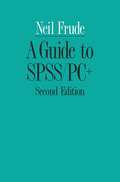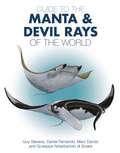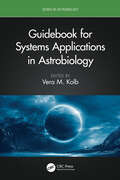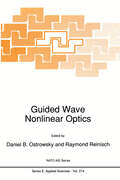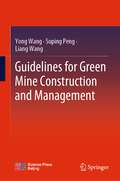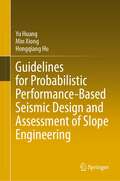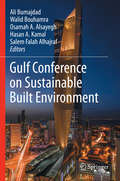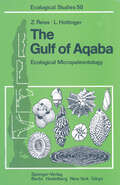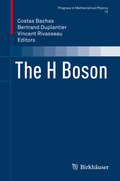- Table View
- List View
A Guide to SPSS/PC+
by Neil FrudeWritten for those with little or no experience in using computers for statistical analysis, this book introduces SPSS/PC+, the market leader PC package. A Guide to SPSS/PC+ teaches the use of SPSS/PC+ clearly and simply. Following the book, which is organized as a progressive tutorial, readers can analyze their own data, or may follow worked examples using the complete dataset which is included. The appendices provide a comprehensive guide for beginners and for those needing to revise their SPSS/PC+ skills. A Guide to SPSS/PC+ is now in its second edition and has been revised to cover the new developments available within Version 4.0 of SPSS/PC.
A Guide to Sustainable Corporate Responsibility: From Theory to Action
by Caroline D. Ditlev-SimonsenThis open access book discusses the challenges and opportunities faced by companies in an age that increasingly values sustainability and demands corporate responsibility. Beginning with the historical development of corporate responsibility, this book moves from academic theory to practical application. It points to ways in which companies can successfully manage their transition to a more responsible, sustainable way of doing business, common mistakes to avoid and how the UN Sustainable Development Goals are integral to any sustainability transformation. Practical cases illustrate key points. Drawing on thirty years of sustainability research and extensive corporate experience, the author provides tools such as a Step-by-Step strategic guide on integrating sustainability in collaboration with stakeholders including employees, customers, suppliers and investors. The book is particularly relevant for SMEs and companies operating in emerging markets. From a broader perspective, the value of externalities, full cost pricing, alternative economic theories and circular economy are also addressed.
The Guide to the Circular Economy: Capturing Value and Managing Material Risk
by Dustin Benton Jonny Hazell Julie HillThe term "Circular Economy" is becoming familiar to an increasing number of businesses. It expresses an aspiration to get more value from resources and waste less, especially as resources come under a variety of pressures – price-driven, political and environmental.Delivering the circular economy can bring direct costs savings to businesses, reduce risk and offer reputational advantages, and can therefore be a market differentiator – but working out what counts as "circular" activity for an individual business, as against the entire economy or individual products, is not straightforward.This guide to the circular economy gives examples of what this new business model looks like in practice, and showcases businesses opportunities around circular activity. It also: explores the debate around circular economy metrics and indicators and helps you assess your current level of circularity, set priorities and measure success; equips readers to make the links between their own company’s initiatives and those of others, making those activities count by influencing actors across the supply chain; outlines the conditions that have enabled other companies to change the system in which they operate. Finally, this expert short work sets the circular economy in a political and business context, so you understand where it has come from and where it is going.
The Guide to the Circular Economy: Capturing Value and Managing Material Risk (Doshorts Ser.)
by Dustin Benton Jonny Hazell Julie HillThe term "Circular Economy" is becoming familiar to an increasing number of businesses. It expresses an aspiration to get more value from resources and waste less, especially as resources come under a variety of pressures – price-driven, political and environmental.Delivering the circular economy can bring direct costs savings to businesses, reduce risk and offer reputational advantages, and can therefore be a market differentiator – but working out what counts as "circular" activity for an individual business, as against the entire economy or individual products, is not straightforward.This guide to the circular economy gives examples of what this new business model looks like in practice, and showcases businesses opportunities around circular activity. It also: explores the debate around circular economy metrics and indicators and helps you assess your current level of circularity, set priorities and measure success; equips readers to make the links between their own company’s initiatives and those of others, making those activities count by influencing actors across the supply chain; outlines the conditions that have enabled other companies to change the system in which they operate. Finally, this expert short work sets the circular economy in a political and business context, so you understand where it has come from and where it is going.
Guide to the Manta and Devil Rays of the World (Wild Nature Press)
by Dr. Guy Stevens Dr. Daniel Fernando Marc Dando Dr. Giuseppe Notarbartolo Di SciaraManta and devil rays are some of the most intriguing creatures in the ocean. Driven forward by powerful beats of wing-like pectoral fins, these filter feeders search the waters for prey, their horn-like head fins giving rise to ancient mariners’ tales of fearsome devilfish dragging boats into the ocean depths. Beloved by scuba divers and marine biologists alike, these impressive animals have never had a comprehensive field guide dedicated to them—until now.Guide to the Manta and Devil Rays of the World includes detailed information on the identification, characteristics, threats, and distribution for each species in this family. Illustrated with more than 200 color photos, drawings, and plates, this guide also contains an expansive introduction to the general taxonomy, biology, and behavior of these iconic animals. This book will be an essential resource for fisheries management and international trade enforcement, and for anyone involved in ongoing manta and devil ray research and conservation. The first dedicated field guide for manta and devil raysExhaustive treatment of every aspect related to their identification and biologyFilled with 200+ color drawings, photos, and diagrams
A Guide to the Systems of Provision Approach: Who Gets What, How and Why
by Kate Bayliss Ben FineUnderstanding consumption requires looking at the systems by which goods and services are provided – not just how they are produced but the historically evolved structures, power relations and cultures within which they are located. The Systems of Provision approach provides an interdisciplinary framework for unpacking these complex issues. This book provides a comprehensive account of the Systems of Provision approach, setting out core concepts and theoretical origins alongside numerous case studies. The book combines fresh understandings of everyday consumption using examples from food, housing, and water, with implications for society’s major challenges, including inequality, climate change, and prospects for capitalism. Readers do not require prior knowledge across the subject matter covered but the text remains significant for accomplished researchers and policymakers, especially those interested in the messy real world realities underpinning who gets what, how, and why across public and private provision in global, national, and historical contexts.
A Guide To U.S. Aircraft Noise Regulatory Policy (Springerbriefs In Applied Sciences And Technology Ser.)
by Sanford Fidell Vincent MestreAviation noise remains the primary hindrance to expansion of airport and airspace capacity in the United States. This book describes the development and practice of U.S. aircraft noise regulation, as well as the practical consequences of regulatory policy. Starting in the pre-jet transport era, the book traces the development of the modern framework for characterizing, standardizing, predicting, disclosing, and mitigating aircraft noise and its effects on airport-vicinity communities. Among other matters, the book treats noise-related consequences of the 1978 deregulation of the airline industry; prediction and mitigation of community reaction to airport noise; land use compatibility planning; recent research and industry trends; and some suggestions for potential improvements to current policy. Initial chapters describe the assumptions underlying aircraft noise regulation, and lay out the chronology of U.S. aircraft noise regulatory practice. Later chapters provide overviews of population-level effects of aviation noise, including health effects, speech and sleep interference, and annoyance. Readers will learn why predictions of the prevalence of aircraft noise-induced annoyance have systematically underestimated adverse community response to aircraft noise, and how such underestimation has complicated approval and funding of airport and airspace improvement projects. They will also learn why attempts at noise-compatible land use planning are seldom fully successful.
A Guidebook for Riverside Regeneration: Artery - Transforming Riversides for the Future
by Frank Bothmann Rudolf Kerndlmaier Albert I. Koffeman Klaus Mandel Sarah Wallbank"Artery" is an initiative on a European scale, funded by the INTERREG IIIB NWE programme, which puts riverside restoration and regeneration at the heart of regional strategies, helping communities across Europe ‘turn back to face the water’. This book discusses the implemented strategies of the Artery initiative, including public-private-partnership, public participation, awareness programs and regional development strategies.
Guidebook for Systems Applications in Astrobiology (Series in Astrobiology)
by Vera M. KolbThis book addresses the timely subject of systems applications in astrobiology. It demonstrates how astrobiology – a multidisciplinary, interdisciplinary, and transdisciplinary field of science – can benefit from adopting the systems approach. Astrobiology draws upon its founding sciences, such as astronomy, physics, chemistry, biochemistry, geology, and planetary sciences. However, astrobiologists can encounter difficulties working across these fields. The systems approach, we believe, is the best contemporary approach to consider astrobiology holistically. The approach is currently used in other fields, such as engineering, which uses systems analysis routinely. Such an approach needs to be learned, both in principle and through examples, from the field. This book features chapters from experts across the field of astrobiology who have applied the systems approach. It will be a valuable guide for astrobiology students at the advanced undergraduate and graduate levels, in addition to researchers in the field, both in academia and the space industry. Key Features: Offers a unique and novel approach to studying and understanding astrobiology Encourages astrobiologists to apply a holistic systems approach to their work, rather than being bogged down in details Imparts practical knowledge to readers which can be adopted in different research and job opportunities in the field of astrobiology Vera M. Kolb obtained degrees in chemical engineering and organic chemistry from Belgrade University, Serbia, and earned her PhD in organic chemistry from Southern Illinois University, Carbondale, Illinois, United States. Following a 30-year career, she is Professor Emerita of Chemistry at the University of Wisconsin-Parkside, Kenosha, Wisconsin. During her first sabbatical leave with the NASA Specialized Center of Research and Training (NSCORT) in Astrobiology, she conducted research with Dr. Leslie Orgel at the Salk Institute and Prof. Stanley Miller at UC San Diego. Her second sabbatical was with Prof. Joseph Lambert at Northwestern University, where she studied sugar silicates and their potential astrobiological relevance. She is credited for authoring over 160 publications, in the fields of organic and medicinal chemistry, green chemistry, and astrobiology, including several books. Recently, she authored Green Organic Chemistry and Its Interdisciplinary Applications (CRC 2016). In the astrobiology field, she edited Astrobiology: An Evolutionary Approach (CRC 2015) and Handbook of Astrobiology (CRC 2019). She co-authored (with Benton C. Clark) Astrobiology for a General Reader: A Questions and Answers Approach (CSP 2020) and Systems Approach to Astrobiology (CRC 2023).
Guidebook for Systems Applications in Astrobiology (Series in Astrobiology)
This book addresses the timely subject of systems applications in astrobiology. It demonstrates how astrobiology – a multidisciplinary, interdisciplinary, and transdisciplinary field of science – can benefit from adopting the systems approach. Astrobiology draws upon its founding sciences, such as astronomy, physics, chemistry, biochemistry, geology, and planetary sciences. However, astrobiologists can encounter difficulties working across these fields. The systems approach, we believe, is the best contemporary approach to consider astrobiology holistically. The approach is currently used in other fields, such as engineering, which uses systems analysis routinely. Such an approach needs to be learned, both in principle and through examples, from the field. This book features chapters from experts across the field of astrobiology who have applied the systems approach. It will be a valuable guide for astrobiology students at the advanced undergraduate and graduate levels, in addition to researchers in the field, both in academia and the space industry. Key Features: Offers a unique and novel approach to studying and understanding astrobiology Encourages astrobiologists to apply a holistic systems approach to their work, rather than being bogged down in details Imparts practical knowledge to readers which can be adopted in different research and job opportunities in the field of astrobiology Vera M. Kolb obtained degrees in chemical engineering and organic chemistry from Belgrade University, Serbia, and earned her PhD in organic chemistry from Southern Illinois University, Carbondale, Illinois, United States. Following a 30-year career, she is Professor Emerita of Chemistry at the University of Wisconsin-Parkside, Kenosha, Wisconsin. During her first sabbatical leave with the NASA Specialized Center of Research and Training (NSCORT) in Astrobiology, she conducted research with Dr. Leslie Orgel at the Salk Institute and Prof. Stanley Miller at UC San Diego. Her second sabbatical was with Prof. Joseph Lambert at Northwestern University, where she studied sugar silicates and their potential astrobiological relevance. She is credited for authoring over 160 publications, in the fields of organic and medicinal chemistry, green chemistry, and astrobiology, including several books. Recently, she authored Green Organic Chemistry and Its Interdisciplinary Applications (CRC 2016). In the astrobiology field, she edited Astrobiology: An Evolutionary Approach (CRC 2015) and Handbook of Astrobiology (CRC 2019). She co-authored (with Benton C. Clark) Astrobiology for a General Reader: A Questions and Answers Approach (CSP 2020) and Systems Approach to Astrobiology (CRC 2023).
Guided Wave Nonlinear Optics (NATO Science Series E: #214)
by D. B. Ostrowsky R. ReinischThe object of this school, held at Cargese, Corsica (France) from August 12th to 24th 1991, was the presentation of the field of guided wave nonlinear optics in a comprehensive, coherent, and heuristic fashion. It seems appropriate that this school began with an historical introduction by Professor Nicolaas Bloembergen of Harvard, the acknowledged "father" of nonlinear optics, in general, and concluded with a round table discussion headed by Dr. Eric Spitz, the Scientific Director of a multinational electronics company interested in developing industrial applications of guided wave nonlinear optics. The lectures covered both the theoretical framework of the field and applications to basic scientific research, optical communications and technical instrumentation. Specific topics developed included materials for guided wave nonlinear optics, nonlinear interactions using integrated optical guides, nonlinear surface waves, solitons, fiber nonlinear optics, ultra-fast coupler switching as well as the related topic of fiber and integrated optical lasers and amplifiers. Lectures have also been devoted to squeezed states, chaos and strange attractors. The subjects covered by the school underlines one of the major ways in which this field has evolved over the past thirty some odd years. The path from the original experiments with materials requiring mega-watt power lasers to the recent developments in guided wave configurations using milliwatt power diode lasers is marked by the conjunction of ever improving fundamental scientific comprehension and continuing technological developments.
Guideline for Salinity Assessment, Mitigation and Adaptation Using Nuclear and Related Techniques
by Mohammad Zaman Shabbir A. Shahid Lee HengThis open access book is an outcome of the collaboration between the Soil and Water Management & Crop Nutrition Section, Joint FAO/IAEA Division of Nuclear Techniques in Food and Agriculture, Department of Nuclear Sciences and Applications, International Atomic Energy Agency (IAEA), Vienna, Austria, and Dr. Shabbir A Shahid, Senior Salinity Management Expert, Freelancer based in United Arab Emirates.The objective of this book is to develop protocols for salinity and sodicity assessment and develop mitigation and adaptation measures to use saline and sodic soils sustainably. The focus is on important issues related to salinity and sodicity and to describe these in an easy and user friendly way. The information has been compiled from the latest published literature and from the authors’ publications specific to the subject matter. The book consists of six chapters. Chapter 1 introduces the terms salinity and sodicity and describes various salinity classification systems commonly used around the world. Chapter 2 reviews global distribution of salinization and socioeconomic aspects related to salinity and crop production. Chapters 3 covers comprehensively salinity and sodicity adaptation and mitigation options including physical, chemical, hydrological and biological methods. Chapter 4 discusses the efforts that have been made to demonstrate the development of soil salinity zones under different irrigation systems. Chapter 5 discusses the quality of irrigation water, boron toxicity and relative tolerance to boron, the effects of chlorides on crops. Chapter 6 introduces the role of nuclear techniques in saline agriculture.
Guidelines for Analysis and Description of Soil and Regolith Thin Sections (ASA, CSSA, and SSSA Books)
by Georges StoopsA revised guide to the study and of soil and regolith thin sections A specialized system of terms and concepts must be used to accurately and effectively distinguish and name the microscopic features of soils and regoliths. With a comprehensive, consistent terminology at their disposal, researchers may compare, store and discuss new data easily and with less risk of error. The second edition of Guidelines for Analysis and Description of Soil and Regolith Thin Sections has been assembled to address this need, offering a practical system of analysis and description to those working with soil and regolith materials. This essential resource includes: An introduction to micromorphology and its practice Guidelines for the study of thin sections Sections covering the various microscopic features of soils and regoliths Illustrative graphics and colour micrographs Suggested description schemes and data presentation tips By providing an economical, navigable system for the study and documentation of soils and regoliths, Guidelines for Analysis and Description of Soil and Regolith Thin Sections, second edition, offers invaluable guidance for soil scientists, geologists, ecologists, archaeologists and all those concerned with micromorphology.
Guidelines for Analysis and Description of Soil and Regolith Thin Sections (ASA, CSSA, and SSSA Books #184)
by Georges StoopsA revised guide to the study and of soil and regolith thin sections A specialized system of terms and concepts must be used to accurately and effectively distinguish and name the microscopic features of soils and regoliths. With a comprehensive, consistent terminology at their disposal, researchers may compare, store and discuss new data easily and with less risk of error. The second edition of Guidelines for Analysis and Description of Soil and Regolith Thin Sections has been assembled to address this need, offering a practical system of analysis and description to those working with soil and regolith materials. This essential resource includes: An introduction to micromorphology and its practice Guidelines for the study of thin sections Sections covering the various microscopic features of soils and regoliths Illustrative graphics and colour micrographs Suggested description schemes and data presentation tips By providing an economical, navigable system for the study and documentation of soils and regoliths, Guidelines for Analysis and Description of Soil and Regolith Thin Sections, second edition, offers invaluable guidance for soil scientists, geologists, ecologists, archaeologists and all those concerned with micromorphology.
Guidelines for Green Mine Construction and Management
by Yong Wang Suping Peng Liang WangThis book comprehensively covers many aspects of green mine, including the basic situation of green mines, mine facilities, extraction management, ecological environment, scientific and technological innovation, standardized management, environmental protection inspectors, and special tools in response to the needs of green mine construction, assessment, and management. It is highly informative with valuable techniques and tools providing insights both for scholars and practitioners working in green mine field.
Guidelines for Probabilistic Performance-Based Seismic Design and Assessment of Slope Engineering
by Yu Huang Min Xiong Hongqiang HuThis book provides a new design and evaluation framework based on slope Stochastic Dynamics theory to probabilistic seismic performance for slope engineering. For the seismic dynamic stability safety of slope, it shifts from deterministic seismic dynamic analysis to quantitative analysis based on nonlinear stochastic dynamics, that is, from qualitative to the description of stochasticity of earthquake excitation that meet the needs in related design specification and establish a performance standard. In the nonlinear dynamic time history analysis of slope subjected to seismic ground motion, the term “randomness” is used to express the uncertainty in the intensity and frequency of earthquake excitation for slope engineering dynamic seismic performance. It mainly includes seismic design fortification standard, corresponding ground motion excitation, performance index threshold, and slope deterministic nonlinear seismic dynamic response. Even more than that, the seismic dynamic large deformation approaches of the whole process and comprehensive analysis for flow analysis after slope instability failure. Eventually, the probabilistic seismic dynamic performance of the slope engineering will be characterized by nonlinear dynamic reliability.
Gulf Conference on Sustainable Built Environment
by Ali Bumajdad Walid Bouhamra Osamah A. Alsayegh Hasan A. Kamal Salem Falah AlhajrafThis volume brings together outstanding contributions to the Gulf Conference on Sustainable Built Environment, held at the Marina Hotel Kuwait, near Kuwait City. The Proceedings collects 29 papers on a range of engineering and materials challenges, and best practices, addressing development of new sustainable building materials, performance improvement of structures and tall buildings, developing monitoring and analysis techniques and frameworks for existing infrastructure under environmental effects, development of long-term sustainability plans for building stock, and development of energy efficient buildings in the gulf region. The Conference was organized by the Kuwait Foundation for the Advancement of Sciences (KFAS), the Massachusetts Institute of Technology, the Kuwait Institute for Scientific Research, and Kuwait University.
The Gulf of Aqaba: Ecological Micropaleontology (Ecological Studies #50)
by Zeev Reiss Lukas HottingerThe reconstruction of ancient marine environments is an important task of the Earth Sciences, of great interest to geology, pure and applied, to oceanography and climatology, as well as to such fields as ecology and evolution. In principle, such reconstructions are based on the actualistic approach of "the present is the key to the past." Since the deciphering of past environmental changes, either nat ural or man-made, has considerable bearing on planning, the past may provide a key to the future. Paleoenvironmental interpretations in the marine realm are based to a great extent on assemblages of fossils recovered from ancient sediments in outcrops and from land-based or submarine drillings. Observable lateral sequences of assemblages in contemporaneous strata, the known or assumed functional or adaptive significance of preserved skeletal struc tures, as well as their evolution through time and space, provide by themselves indications of ancient environmental settings. In some cases even present-day eco logical considerations may be derived from analysis of fossils.
Gully Erosion Studies from India and Surrounding Regions (Advances in Science, Technology & Innovation)
by Pravat Kumar Shit Hamid Reza Pourghasemi Gouri Sankar BhuniaThis book offers the scientific basis for the ample evaluation of badland management in India and some surrounding regions. It examines the processes operating in the headwaters and main channels of ephemeral rivers in lateritic environments of India. In particular, the book covers a range of vital topics in the areas of gully erosion and water to soil erosion at lateritic uplands regions of India and other regions in Asia. It explores the probable gully erosion modeling through Remote Sensing & GIS Techniques. It is divided into three units. Unit I deals with the introduction of badland, types of badland and the process of badland formation. Unit II is devoted to a description of quantitative measurements. Unit III deals with the control and management processes related to various issues from different regions. As such this book serves as a reference book for research activities in this area. It is an efficient guide for aspiring researchers in applied geography, explaining advanced techniques to help students recognize both simple and complex concepts.
Guns, Germs And Steel: A Short History Of Everybody For The Lst 13,000 Years (Patterns Of Life Ser.)
by Jared Diamond'A book of big questions, and big answers' Yuval Noah Harari, bestselling author of SapiensWITH A NEW AFTERWORD FROM THE AUTHOR Why has human history unfolded so differently across the globe?In his Pulitzer Prize-winning book, Jared Diamond puts the case that geography and biogeography, not race, moulded the contrasting fates of Europeans, Asians, Native Americans, sub-Saharan Africans, and aboriginal Australians. An ambitious synthesis of history, biology, ecology and linguistics, Guns, Germs and Steel remains a ground-breaking and humane work of popular science.
Gyro-Free Inertial Navigation Technology (Navigation: Science and Technology #7)
by Hongjin Zhou Yunhai Zhong Hui Song Su WangThis book focuses on gyro-free inertial navigation technology, which is used to measure not only linear motion parameters but also angular rates. Since no gyroscopes are used, the key technologies, such as initial alignment, attitude resolution, and error calibration, are very different than those used in traditional methods.Discussing each key technology in gyro-free inertial navigation system (GFINS) manufacture in a separate chapter, the book features easy-to-understand, detailed illustrations, to allow all those involved in inertial navigation to gain a better grasp of GFINS manufacture, including accelerometer setting principles; initial alignment; quaternion-based, attitude resolution algorithms; and accelerometer de-noise methods.
H.A. Kramers Between Tradition and Revolution
by Max DresdenIt is now a little more than 11 years since the idea of writing a personal and scientific biography of H. A. Kramers took hold of me. A few days earlier I had been lecturing, in a course on field theory, on the renormalization proce dures of relativistic quantum field theory. Since the students had considerable trouble understanding the physical basis of the procedure, at the end of the lecture T explained that renormalization is not an exclusive quantum or relativistic procedure. A careful treatment of classical electron theory as started by Lorentz and developed in detail by Kramers also requires re normalization. The students appeared quite interested and I promised them that I would explain all this in more detail in the next lecture. I could have looked up this material in Kramers' book, but I remembered that Kramers had stressed this idea in a course I had attended in Leiden in 1938-1939. I did dig up some of these old notes and, although they were considerably less transparent than my recollection seemed to indicate, they reminded me force fully of the thrilling days I had spent in Leiden with Kramers. Kramers' deep insight and originality were apparent even when distorted by my opaque notes. The students had never heard of these ideas of Kramers' and were totally unaware of his work in field theory.
The H Boson (Progress in Mathematical Physics #72)
by Costas Bachas Bertrand Duplantier Vincent RivasseauThis volume provides a detailed description of the seminal theoretical construction in 1964, independently by Robert Brout and Francois Englert, and by Peter W. Higgs, of a mechanism for short-range fundamental interactions, now called the Brout-Englert-Higgs (BEH) mechanism. It accounts for the non-zero mass of elementary particles and predicts the existence of a new particle - an elementary massive scalar boson. In addition to this the book describes the experimental discovery of this fundamental missing element in the Standard Model of particle physics. The H Boson, also called the Higgs Boson, was produced and detected in the Large Hadron Collider (LHC) of CERN near Geneva by two large experimental collaborations, ATLAS and CMS, which announced its discovery on the 4th of July 2012.This new volume of the Poincaré Seminar Series, The H Boson, corresponds to the nineteenth seminar, held on November 29, 2014, at Institut Henri Poincaré in Paris.
The H-Function: Theory and Applications
by A.M. Mathai Ram Kishore Saxena Hans J. HauboldTheH-function or popularly known in the literature as Fox’sH-function has recently found applications in a large variety of problems connected with reaction, diffusion, reaction–diffusion, engineering and communication, fractional differ- tial and integral equations, many areas of theoretical physics, statistical distribution theory, etc. One of the standard books and most cited book on the topic is the 1978 book of Mathai and Saxena. Since then, the subject has grown a lot, mainly in the elds of applications. Due to popular demand, the authors were requested to - grade and bring out a revised edition of the 1978 book. It was decided to bring out a new book, mostly dealing with recent applications in statistical distributions, pa- way models, nonextensive statistical mechanics, astrophysics problems, fractional calculus, etc. and to make use of the expertise of Hans J. Haubold in astrophysics area also. It was decided to con ne the discussion toH-function of one scalar variable only. Matrix variable cases and many variable cases are not discussed in detail, but an insight into these areas is given. When going from one variable to many variables, there is nothing called a unique bivariate or multivariate analogue of a givenfunction. Whatever be the criteria used, there may be manydifferentfunctions quali ed to be bivariate or multivariate analogues of a given univariate function. Some of the bivariate and multivariateH-functions, currently in the literature, are also questioned by many authors.
H2Karst Research in Limestone Hydrogeology (Environmental Earth Sciences)
by Jacques Mudry François Zwahlen Catherine Bertrand James W. LaMoreauxChapters in this book are contributions from the 9th Conference on limestone hydrogeology, organized in Besançon in September 2011 selected by the scientific committee of H2Karst.The book presents latest results on in the field of groundwater flow and storage within the different subsystems of karst aquifers; insights into the complex interaction between groundwater and surface water in karst areas by a multidisciplinary approach; current knowledge on contamination problems and contaminant transport in karst aquifers as well as an overview of karst hydrogeology in different contexts around the world.
